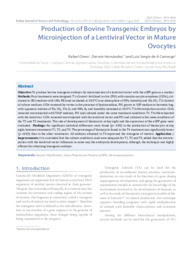Production of bovine transgenic embryos by microinjection of a lentiviral vector in mature ovocytes.
Production of bovine transgenic embryos by microinjection of a lentiviral vector in mature ovocytes.
Author(s): OTERO, R.; HERNÁNDEZ, D.; CAMARGO, L. S. de A.
Summary: Abstract Objective: To produce bovine transgenic embryos by microinjection of a lentiviral vector with the eGFP gene as a marker. Methods: Four treatments were designed: T1=Control: fertilized in vitro (FIV) with cumulus-oocyte complexes (CCOs), cultivated in CR2 medium with 10% FBS and incubated at 38.5°C in an atmosphere of 95% humidity and 5% CO₂. T2=Control of culture medium: CCOs removed by vortex in the presence of hyaluronidase, FIV, grown in SOF medium in hermetic bag, with a gaseous mixture of 5% CO₂, 5% O₂ and 90% N₂ and humidity saturated at 38.5°C. T3=Microinjection control: CCOs removed microinjected with TALP medium, FIV and cultured under the same treatment conditions T2. T4=Microinjected with the lentivirus: CCOs removed microinjected with the lentiviral vector and FIV and cultured in the same conditions of the T2 and T3 treatments. The rate of development of blastocysts at day eight and the expression of the eGFP gene were evaluated. Findings: No significant statistical differences were found (p> 0.05) in the production of blastocysts at day eight, between treatments T1, T2, and T3. The percentage of blastocysts found in the T4 treatment was significantly lower (p <0.05) than in the other treatments. All embryos obtained in T4 expressed the transgene of interest. Application / Improvements: It is concluded that the culture conditions used were adequate for T1, T2 and T3, added that the microinjection with the lentiviral vector influences in some way the embryonic development, although, the technique was highly efficient for obtaining transgenic embryos.
Publication year: 2018
Types of publication: Journal article
Unit: Embrapa Dairy Cattle
Observation
Some of Embrapa's publications are published as ePub files. To read them, use or download one of the following free software options to your computer or mobile device. Android: Google Play Books; IOS: iBooks; Windows and Linux: Calibre.
Access other publications
Access the Agricultural Research Database (BDPA) to consult Embrapa's full library collection and records.
Visit Embrapa Bookstore to purchase books and other publications sold by Embrapa.

